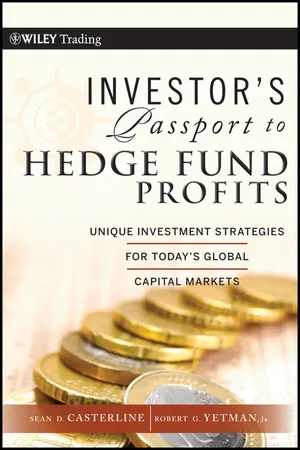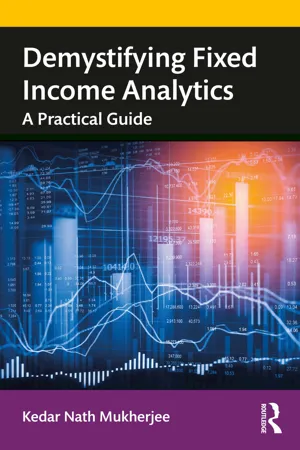Economics
Hedging Derivatives
Hedging derivatives are financial instruments used to mitigate or offset the risk associated with price fluctuations in assets such as commodities, currencies, or securities. They allow investors and businesses to protect themselves from potential losses by locking in prices or rates for future transactions. Common types of hedging derivatives include options, futures contracts, and forward contracts.
Written by Perlego with AI-assistance
Related key terms
Related key terms
1 of 4
Related key terms
1 of 3
9 Key excerpts on "Hedging Derivatives"
- Manolis G. Kavussanos, Dimitris A. Tsouknidis, Ilias D. Visvikis(Authors)
- 2021(Publication Date)
- Routledge(Publisher)
The core function of the financial system is to facilitate the allocation and development of economic resources, both spatially and across time, in an uncertain environment (Merton, 1990). The economic function of financial markets can be seen in three dimensions: time, risk and information. The intertemporal (over time) nature of financial decisions implies uncertainty as to the future outcomes of key variables, such as equity prices, foreign exchange rates, interest rates, commodity prices, freight rates, etc. This uncertainty encompasses the possibility of a financial loss. For instance, an oil refinery does not know in August what price it will have to pay in October for crude oil to continue its refining operations. The possibility of a rise in the crude’s price by October constitutes a risk for the refinery, as this will increase its input costs. Money and capital markets provide a wide range of instruments or institutional arrangements to either diversify away risks (hedge), i.e. to reduce or eliminate risks, or to (re)allocate the undiversifiable part of the risks among households and companies, from those who want to avoid it to those who are willing to accept it for an expected return.The origin of the term “hedging” is unclear, but it appears to derive from the use of hedges to form a protective or defensive barrier around property. In a business context, the term means “to secure oneself against a loss on an investment by investing on the other side” (Arditti, 1996). Hedging is insuring (protecting) against changes in the market, so that the buyer or seller in the market is protected against adverse changes in prices in the future.1 Before implementing a hedge, various issues should be considered: Identification of the potential risk exposure, calculation of the risk exposure, selection of the appropriate hedging instrument, calculation of the size of the hedge, and finally monitoring of the hedge. The available methods of hedging depend upon the form of risk and the investors’ preferences. Companies and individual investors can use modern risk management instruments, such as financial derivatives, in order to hedge their risks. Financial derivatives are contracts which have a price. This price depends, amongst other things, on the value of the underlying asset upon which the contract is written. Hence the name derivative – its value derives from that of another asset, known as the “underlying asset” or the “underlying commodity- eBook - ePub
Investor's Passport to Hedge Fund Profits
Unique Investment Strategies for Today's Global Capital Markets
- Sean D. Casterline, Robert G. Yetman(Authors)
- 2010(Publication Date)
- Wiley(Publisher)
Derivatives are financial instruments, the prices of which are derived from the value of something else, which is usually called “the underlying.” The underlying on which a derivative is based can be the price of an asset, like stocks, commodities, or residential mortgages, or even an index, like interest rates, exchange rates, stock market indexes, consumer price index (CPI), or other similar sorts of benchmarks; credit derivatives, the most famous kind in these days following the implosion of global financial markets in 2008, are based on loans, bonds, or other forms of credit. The principal types of derivatives are forwards, futures, options, and swaps. Derivatives can be used to mitigate the risk of economic loss arising from changes in the value of the underlying security. This activity is known as hedging. For example, if you held a position in the stock of Nestlé and felt its longer-term prospects were strong, but that short-term inventory problems would force the stock down in the coming quarters, you may decide to buy put options to protect your position as Nestlé went through a corrective phase. Alternatively, derivatives can be used by investors to take a risk and make a profit if the value of the underlying security moves the way they expect. This form of derivatives use is much more aggressive and is known as speculation. It may suit the palate of some investors to go out on a limb in such a fashion, but the majority of this chapter is going to be geared toward how to use derivative instruments to shore up your portfolio, and not for the purpose of speculation. We will be chiefly speaking of options and futures. We thought about including a section for swaps but decided that the swaps market is not as readily accessible to investors and is, for the most part, institutionalized. When we started out to write this book, we wanted to strive for something you could use and practically apply in creating your own hedge-type portfolio - eBook - ePub
- Indranarain Ramlall(Author)
- 2018(Publication Date)
- Emerald Publishing Limited(Publisher)
Chapter 4
Derivatives and Financial Stability
4.1. Derivatives
Derivatives constitute sophisticated financial instruments which are used by traders in the world for various purposes. The three main types of traders in derivatives are speculators, arbitrageurs and hedgers. Speculators are traders which undertake risky transactions in view of generating large profits. The risk involved is usually high, and in extreme cases, speculators can even kill the markets. Arbitrageurs represent traders who pocket riskless profits by availing themselves of short-term inefficiencies in the markets. Finally, hedgers are those traders who buy derivatives in order to reduce risk.There are four major types of derivatives in the world, namely futures, forwards, swaps and options. Among these four categories, options tend to be imbued with complex structures, alternatively known as asymmetric payoff profiles. Futures and forwards share similar linear payoff profiles. Swaps mainly represent the exchange of cash flows, whether in the same or different currencies, mostly in view of mitigating interest rate risk or currency risk.However, it is of paramount significance to note that derivatives mishaps can be very costly. As pointed out by Hull (2010), big losses in derivatives occurred for both financial and non-financial institutions in the world, as shown in the Boxes 4.1 and 4.2 - eBook - ePub
Futures Markets (Routledge Revivals)
Their Establishment and Performance
- Barry Goss(Author)
- 2013(Publication Date)
- Routledge(Publisher)
3 HEDGING, RISK AND PROFITS: NOTES ON MOTIVES FOR HEDGING ON FUTURES MARKETSBasil Yamey*
1. Hedging and Price Risks
Once upon a time hedging by means of transactions in futures contracts was almost universally regarded as a practice intended by the hedger to avoid, reduce or eliminate the risk of price changes by shifting that risk on to others willing to bear it. Hedging was almost always defined, described or discussed in these terms, both in materials addressed to those engaged in business and also in academic publications. The analogy with insurance was commonly drawn. Here are some quotations from the work of the leading academic authors who had addressed themselves to the economics of futures trading before the Second World War.For Alfred Marshall, the hedger ‘does not speculate: he insures’. The short hedger ‘by buying a future … does not speculate; he throws on the shoulders of the general market the risks and the chances of gain that would have come to him through general movements external to his own business’ (Marshall, 1919, p. 260). J.G. Smith wrote that the ‘essence of the operation [of hedging]’ is for the hedger to eliminate ‘speculative risks for himself’. Hedging enables hedgers ‘to insure against the risk of price fluctuations’ (Smith, 1922, pp. 81, 95). Charles O. Hardy wrote that the hedger ‘is securing protection against a definite risk in much the same way that one secures protection against unknown hazard through Lloyd’s policy’ (Hardy, 1923, p. 72).As is well known, John Maynard Keynes discussed hedging in terms of risk avoidance and insurance (Keynes, 1930, vol. 2, pp. 142–4). John Hicks explained that the ‘ordinary business man only enters into a forward contract if by so doing he can “hedge” — that is to say, if the forward transaction lessens the riskiness of his position’ (Hicks, 1939, p. 137). And Kaldor pithily expressed the by then familiar notion that ‘it is the speculators who assume the risks and the hedgers who get rid of them’ (Kaldor, 1939–40, p. 197). - Gary Shoup(Author)
- 2013(Publication Date)
- Routledge(Publisher)
Transactional Hedging (Short-Term): This method is used for hedging accounting exposure of less than a year in duration. The hedging results become immediately apparent with such short-term actions. Transactions in short-term financial instruments relate more to day-to-day management decisions than to long-range planning.Currency Derivatives
The complexities of derivatives are manageable to anyone comfortable with the concept of parallel markets. Derivatives are the contracts in the various foreign exchange markets: forwards, futures, options and swaps.* The markets for these instruments all closely parallel the spot currency market. A currency derivative is defined as follows:A currency derivative is (1) a contract or financial agreement to exchange two currencies at a predetermined rate, or (2) a contract or financial agreement whose value is derived from the rate of exchange of two currencies at spot In either case, the exchange of currency may be actual or implied.Currency derivatives trade in markets that parallel the spot market, so spot (cash) market exposures can be hedged with currency derivatives. The spot rate is the price of the “underlying currency.” One advantage of derivative hedging is the number of markets available, all moving parallel to the underlying currency. Geometry teaches us that when two lines are parallel to a third line, they are parallel to each other. Thus, all derivative markets of a particular currency parallel each other, allowing a wide variety of hedging tactics (See Figure 9-6 for examples of currency derivatives).Following are six diagrams that review derivatives with an emphasis on their interrelationships. Figure 9-7 portrays a simple spot currency exchange between a corporate customer and its bank, based on a spot rate of exchange of FC/HC = 2.00. Spot transactions settle in two business days.Non-spot transactions take longer to settle. The delivery, or exchange, of currencies can take place on any “good” business day. A “good” day means the banks are open that day in both countries to effect delivery. Figure 9-8- eBook - ePub
Demystifying Fixed Income Analytics
A Practical Guide
- Kedar Nath Mukherjee(Author)
- 2020(Publication Date)
- Routledge India(Publisher)
8 Financial derivative contractsKey learning outcomesAt the end of this chapter, readers are expected to be familiar with:- Various concepts of derivatives markets and products: exchange traded vs. OTC market; forwards, futures, swaps, and options (call and put).
- Present status of financial derivatives markets worldwide and in India.
- Role of derivatives as a “useful financial innovation” and as a “weapon of mass destruction”.
- Estimation of payoffs to buyer and seller.
- Advantages/uses of derivatives contracts.
- Risks in and risk management of different types of derivative instruments.
A derivative may be defined as a financial instrument whose value depends on the value of another underlying asset. The International Monetary Fund (IMF) defines derivatives as:Financial derivatives: meaning & types of contractsfinancial instruments that are linked to a specific financial instrument or indicator or commodity and through which specific financial risks can be traded in financial markets in their own right. The value of a financial derivative derives from the price of an underlying item such as an asset or index. Unlike debt securities, no principal is advanced to be repaid and no investment income accrues. - eBook - ePub
- R. Venkata Subramani(Author)
- 2011(Publication Date)
- Wiley(Publisher)
non-hedging activities .HedgingOne of the key factors in a derivative instrument is that derivatives form an effective medium of transferring risk from a person who wants to avoid risk to a person with a greater tolerance for risk.Non-hedging Non-hedging motives could be either speculation or for arbitrage.Arbitrage is taking advantage of a price differential between two or more markets. Arbitrage refers to the purchase and sale of similar products in two or more different markets in order to take advantage of price discrepancy. A person who engages in arbitrage is called an arbitrageur .When the prices for the futures are greater than the cash prices including the cost of carry, the arbitrageur will purchase the securities from the cash market and will sell in the futures market. This is known as long arbitrage . When the prices for the futures including the adjustment for cost of carry are lower than the cash prices, the arbitrageur will sell in the cash market and will purchase in the futures market; this is known as short arbitrage .If the market prices do not allow for profitable arbitrage, the prices are said to constitute an arbitrage equilibrium or arbitrage-free market. Arbitrage helps with price discovery. Price discovery is the process of determining the spot prices in any market. Prices are dependent upon supply and demand. When the demand for a particular commodity is higher than its supply, the price will typically increase and vice versa.Speculators in futures markets provide the essential function of assuming risk in the hope of getting a reward. The speculator has no intention of taking actual delivery of the securities purchased. Limitations of the Forwards Market Liquidity Issues The forwards market is customized and hence liquidity is an issue. Lack of liquidity also means there will not be proper price discovery. - eBook - ePub
Essays in Derivatives
Risk-Transfer Tools and Topics Made Easy
- Don M. Chance(Author)
- 2011(Publication Date)
- Wiley(Publisher)
Managing Financial Risk: A Guide to Derivative Products, Financial Engineering, and Value Maximization , 3rd ed. New York: McGraw-Hill, 1998, chap. 20.Stulz, René. Risk Management and Derivatives . Mason, OH: Thomson South-Western, 2003, chap. 3.TEST YOUR KNOWLEDGE1. What is the primary reason for using derivatives?2. If a hedge is put in place and the risk is completely eliminated, the hedger earns the risk-free rate. Why would a hedger do this when it could earn the risk-free rate by investing directly in the risk-free asset? Why go to so much trouble to put on a hedge?3. What role do speculators play in derivatives markets?4. Why does risk management not always involve hedging?5. For what personal reason do managers sometimes make their companies hedge?1 This description is basically that of an option. Forwards, futures, and swaps do not involve a direct payment from buyer to seller, but they can be viewed as having indirect payments in the form of the buyer promising to give up potential future gains.2 “Short selling” is a term primarily used with stocks and bonds and means to borrow the asset and sell it in hopes of buying it back at a later date at a lower price. The short seller then returns the borrowed asset to the lender. In derivatives markets, no one actually borrows anything and in fact, the term “short selling” is rarely used. You simply “sell” or “go short” a derivative, which is nothing more than taking the opposite side of the contract from the buyer, thereby guaranteeing to do whatever is obligated by the contract at the later date. This not to say that short selling is not without risk. Most short positions have considerable risk, but the point is that it is much easier to enter into a short position in a derivative than in the underlying asset.3 - eBook - ePub
Community Banking Strategies
Steady Growth, Safe Portfolio Management, and Lasting Client Relationships
- Vince Boberski(Author)
- 2010(Publication Date)
- Bloomberg Press(Publisher)
Chapter 9Derivatives as a Way to Manage Balance Sheet, Earnings, and Business RiskOF ALL THE PRODUCTS available to community banks, derivatives have always carried some of the scariest connotations (rivaled now, perhaps, by pooled TruPS, and agency preferreds). That reputation is in some ways understandable given the role that structured products played in the financial meltdown of the past couple of years. Anyone even remotely exposed to finance has seen plenty of traders in dark suits and handcuffs taking the walk of shame on TV. Derivatives are the handguns of the financial world: powerful tools that are not necessarily bad in and of themselves but disastrous if put into the wrong hands. Even the most plain-vanilla product carries a lot of leverage. In this case, however, I will not be talking about the headline makers. This chapter focuses on interest rate swaps and, to a lesser extent, on caps and floors.There are two broad ways to use derivatives at the community bank level:1. as an interest-rate risk-management tool, and 2. as a way to help develop and maintain client relationships.The first set of uses typically includes hedging a specific set of assets (such as a prime-based loan book) or liabilities (such as a floating-rate TruP or a book of CDs) rather than as macro balance-sheet hedges. The essential idea behind those strategies is to shift income forward or backward with a view toward the institution’s overall interest-rate risk profile (typically a projection of margins and net interest income). This is exactly what community bank management teams do when they extend or shorten the duration of their bond portfolios to counter either too much asset or liability sensitivity. Derivatives are nothing more than a way to affect the same types of changes in a more capital-efficient way.One important aspect of an interest-rate risk-management process with derivatives is the decision to use a swap or a cap or a floor as the tool. A big difference between the two is how the bank pays for them. Caps and floors are like insurance policies in that the user pays the premium up front. That premium is the maximum amount that the bank would be out if it turns out that interest rates did not move in the anticipated direction (which is fine because the bank itself or the hedged asset or liability most likely performed well in that case). Premiums are quoted in basis points, and a list of the major factors that drive those premiums follows in the appendix to this chapter. The decision about what type of derivative to use in large part comes down to how closely it mirrors an existing or potential risk. In most cases, community banks will find that swaps do a better job of managing the interest rate and income risk associated with specific assets and liabilities. Community banks seldom employ macro, or balance-sheet-wide hedging strategies; I discuss the reasons for that in the following section.
Index pages curate the most relevant extracts from our library of academic textbooks. They’ve been created using an in-house natural language model (NLM), each adding context and meaning to key research topics.
Explore more topic indexes
Explore more topic indexes
1 of 6
Explore more topic indexes
1 of 4








